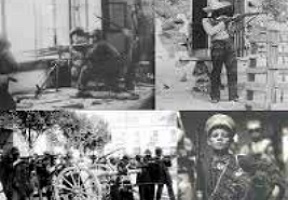By: Daniel Nardini
 Long lost in the tropical rain forests for centuries in the southern Yucatan peninsula, the great Mayan pyramids were being rediscovered by both American and Mexican archaeologists in the late 19th and early 20th centuries. The towering ancient buildings that had been constructed long before the Spanish ever set foot in the Americas were being found. The astounding architecture, the masterful construction, and the incredible planning that had gone into the Mayan pyramids and the plazas that were part of the urban environment of the Mayan city-states centuries ago renewed greater interest in not only the Mayans of the past but also of the present. Anthropologists wanted to know more about the Mayans and how they created these marvels. The early Spanish conquistadors and missionaries destroyed many Mayan books that might have provided valuable information about the ancient Mayans, but archaeologists were able to find ancient Mayan books and other artifacts that had been buried in their long forgotten pyramids. This also sparked a keen interest in the current Mayan culture, language, and their remembrance of their own history.
Long lost in the tropical rain forests for centuries in the southern Yucatan peninsula, the great Mayan pyramids were being rediscovered by both American and Mexican archaeologists in the late 19th and early 20th centuries. The towering ancient buildings that had been constructed long before the Spanish ever set foot in the Americas were being found. The astounding architecture, the masterful construction, and the incredible planning that had gone into the Mayan pyramids and the plazas that were part of the urban environment of the Mayan city-states centuries ago renewed greater interest in not only the Mayans of the past but also of the present. Anthropologists wanted to know more about the Mayans and how they created these marvels. The early Spanish conquistadors and missionaries destroyed many Mayan books that might have provided valuable information about the ancient Mayans, but archaeologists were able to find ancient Mayan books and other artifacts that had been buried in their long forgotten pyramids. This also sparked a keen interest in the current Mayan culture, language, and their remembrance of their own history.
But the rediscovery of the Mayans in terms of their long lost civilization, their culture and language led to the rediscovery and study of other indigenous groups in Mexico. Soon anthropologists were studying the Nahuas (the descendants of the Aztecs), the Tarascans, the Zapotecs, the Otomi, the Chichimecs, etc. It was becoming clear that Mexico had a past well beyond the Spanish colonial period, and that the native peoples who still remained were the original inhabitants of the country that would become Mexico. The name of Mexico itself came from the word Mexica; another name for the Aztecs. But Mexico was not just the land of the Aztecs. The country encompassed many other indigenous peoples who had been there along with the Aztecs. The Tarascans had also built an empire equal in size to that of the Aztecs, and whose trade network extended into the southern Yucatan peninsula as they traded with the Mayans. As anthropologists and archaeologists were finding more artifacts about the native peoples of Mexico, their collections found their way into the National Mexican Museum.
In 1906, then Mexican President Porfirio Diaz had the collection moved to the newly constructed Chopo building which was built for the purpose of the collection. As the collection grew, it became obvious that the new building was not large enough for the growing collection, so it was moved into a newer building. In 1910, the new museum called the National Museum of Archaeology, History and Ethnography opened. It became the crowning achievement of the Diaz administration. During his long reign, Mexico had grown stable and overall economically prosperous.









